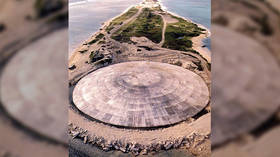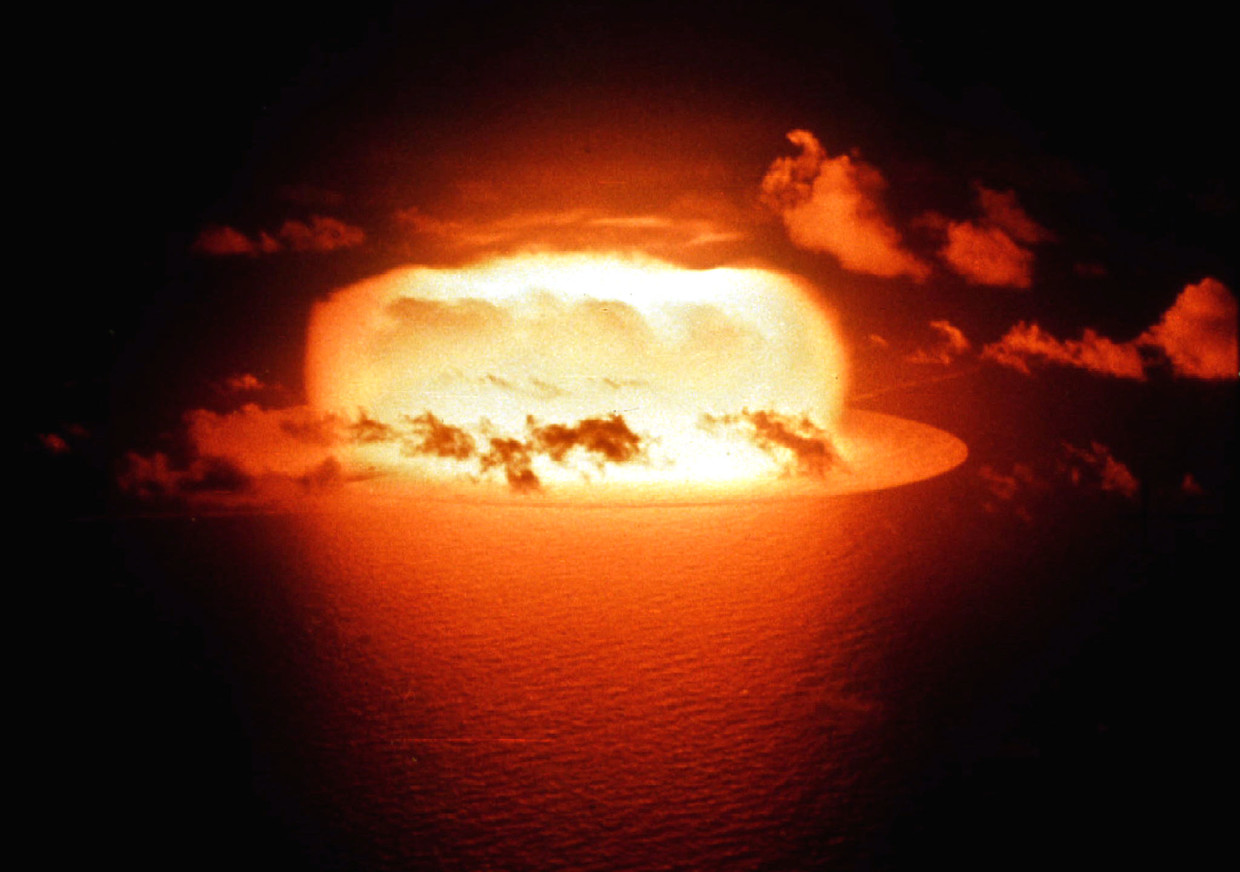- Joined
- Nov 29, 2016
- Messages
- 5,674
- Points
- 63
https://www.rt.com/news/459499-un-confirms-nuclear-waste-pacific/
HomeWorld News
Cold War ‘nuclear coffin’ leaking radioactive waste from US tests into Pacific Ocean – UN chief
Published time: 16 May, 2019 14:26 Edited time: 16 May, 2019 14:53
Get short URL

© AFP / US Defense Nuclear Agency / Giff Johnson
While the imposing structure at Enewetak Atoll in the Marshall Islands may look like something from a James Bond movie, Guterres described it as a “kind of coffin:” a stern reminder of the aftermath of American atomic weapons testing.
The soil irradiated by the tests and ash from the fallout were dumped into a crater which was then capped with 18 inches of concrete, measures that have proved ineffective at containing the waste in the long run. The bottom of the crater was reportedly never lined at all.

The light from an atomic bomb test explosion (Operation Redwing, Shot Erie) is reflected in the waters of Enewetak Atoll May 30 1956. © Reuters
Guterres confirmed the disturbing information while speaking to students in Fiji as a part of a tour of the South Pacific focusing on climate change and environmental issues. The leakage, according to Guterres, has already begun to have its effect.
One such test was the 1954 ‘Bravo’ hydrogen bomb, which remains the most powerful US-tested atomic weapon. Its explosion was 1,000 times bigger than the atomic bombs used on Japan.
Also on rt.com US used Hiroshima atomic bomb victims as ‘guinea pigs’, survivor tells RT
The native people who lived on the Marshall Islands had to be forcibly evacuated and resettled by the US administration. Nonetheless, many ended up exposed to nuclear fallout from the tests.
While Guterres had no specific recommendations for how to minimize the impact, he warned that action needs to be taken soon. A powerful storm in the region could end up damaging the cover further, which would have devastating results for the environment.
HomeWorld News
Cold War ‘nuclear coffin’ leaking radioactive waste from US tests into Pacific Ocean – UN chief
Published time: 16 May, 2019 14:26 Edited time: 16 May, 2019 14:53
Get short URL

© AFP / US Defense Nuclear Agency / Giff Johnson
- 1618
- 21
While the imposing structure at Enewetak Atoll in the Marshall Islands may look like something from a James Bond movie, Guterres described it as a “kind of coffin:” a stern reminder of the aftermath of American atomic weapons testing.
The soil irradiated by the tests and ash from the fallout were dumped into a crater which was then capped with 18 inches of concrete, measures that have proved ineffective at containing the waste in the long run. The bottom of the crater was reportedly never lined at all.
The light from an atomic bomb test explosion (Operation Redwing, Shot Erie) is reflected in the waters of Enewetak Atoll May 30 1956. © Reuters
Guterres confirmed the disturbing information while speaking to students in Fiji as a part of a tour of the South Pacific focusing on climate change and environmental issues. The leakage, according to Guterres, has already begun to have its effect.
The consequences have been quite dramatic, in relation to health, in relation to the poisoning of waters in some areas.
Aside from being used to store the dangerous atomic waste, Guterres discussed how the Pacific had been victimized while under US administration. The islands and atolls far off the south east coast of Japan such as Enewetak were the sites of 67 American nuclear weapons tests that took place between 1946-58.One such test was the 1954 ‘Bravo’ hydrogen bomb, which remains the most powerful US-tested atomic weapon. Its explosion was 1,000 times bigger than the atomic bombs used on Japan.
Also on rt.com US used Hiroshima atomic bomb victims as ‘guinea pigs’, survivor tells RT
The native people who lived on the Marshall Islands had to be forcibly evacuated and resettled by the US administration. Nonetheless, many ended up exposed to nuclear fallout from the tests.
While Guterres had no specific recommendations for how to minimize the impact, he warned that action needs to be taken soon. A powerful storm in the region could end up damaging the cover further, which would have devastating results for the environment.
